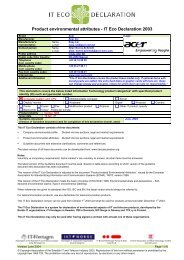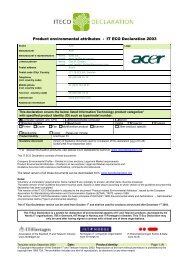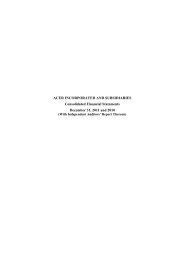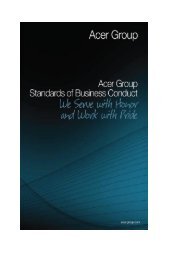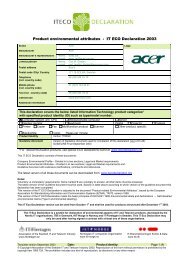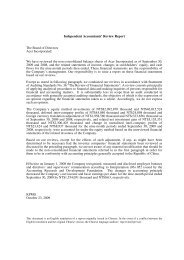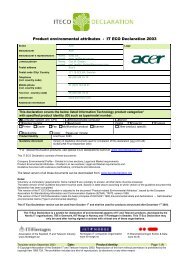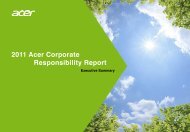2009 Corporate Responsibility Report - Acer Group
2009 Corporate Responsibility Report - Acer Group
2009 Corporate Responsibility Report - Acer Group
You also want an ePaper? Increase the reach of your titles
YUMPU automatically turns print PDFs into web optimized ePapers that Google loves.
<strong>Acer</strong> <strong>Corporate</strong> <strong>Responsibility</strong> <strong>Report</strong> <strong>2009</strong><br />
It's Time for Environmental <strong>Responsibility</strong><br />
Green Product Management<br />
International environmental regulations can roughly be divided into<br />
three categories: chemicals, energy efficiency, and recycling. <strong>Acer</strong><br />
follows this model by evaluating the eco-friendliness of its products<br />
in terms of materials, energy, and recycling. By carefully examining<br />
the whole life cycle of our products we have been able to develop<br />
high-quality items that are energy and resource efficient, easy<br />
to recycle, and low in pollutants and hazardous substances.<br />
By employing green purchasing and communications with our<br />
suppliers we have been able to establish a green supply chain that<br />
is thoroughly in line with international environmental practice.<br />
Energy<br />
Material<br />
Eco-Friendly<br />
Life Cycle<br />
Thinking<br />
Recycling<br />
Green Product Policy<br />
• Based on the life cycle concept, we offer high-quality<br />
products that are energy and resource efficient, low in<br />
pollutants and hazardous substances, and easy to recycle.<br />
• By employing green purchasing and communications<br />
with our suppliers we have been able to establish a green<br />
supply chain that is thoroughly in line with international<br />
environmental practice.<br />
Materials Selection Management<br />
1. Restrictions on the Use of Chemicals<br />
In 2005, the EU announced the Directive on the Restriction of the<br />
Use of Certain Hazardous Substances in Electrical and Electronic<br />
Equipment (RoHS). <strong>Acer</strong> responded by creating a team charged<br />
with overseeing the environmental safety of our global operations. In<br />
2006, we began the first stage of our Hazardous Substances Free,<br />
HSF, program – based on the precautionary principle and Individual<br />
Producer <strong>Responsibility</strong> – to remove PVC, BFRs and phthalates<br />
from our products. In conjunction with our suppliers we conducted a<br />
thorough review of our products in the search for substitute materials<br />
and technology. In addition, the promulgation of the EU's Regulations<br />
for the Registration, Evaluation, Authorisation and Restriction of<br />
Chemicals, REACH, on June 1, 2007, prodded us to gain a deeper<br />
understanding of the levels of Substances of Very High Concern,<br />
SVHCs, in our products in keeping with the precautionary spirit of<br />
REACH.<br />
We also strictly require that our suppliers continue to restrict or phase<br />
out the use of hazardous substances in our products, as laid out in the<br />
<strong>Acer</strong> Guidance of Restricted Substances in Products. This works to<br />
effectively reduce environmental pollution and direct impacts on human<br />
health due to inappropriate disposal of waste electric and electronic<br />
products. We originally made it a corporate target to completely phase<br />
out the use of PVC, BFRs, and phthalates in our products by <strong>2009</strong>.<br />
We started on the task of integrating internal and external resources in<br />
2005 and were able to market a number of products that had BFR-free<br />
printer circuit boards and casings. <strong>Acer</strong> anticipates that new legislation<br />
supporting halogen-free products will lead to restrictions on the use<br />
of PVC and BFRs while also effectively reducing environmental<br />
impacts resulting from inappropriate disposal of electronics waste. <strong>Acer</strong><br />
supports the move to phase out all brominated and chlorinated organic<br />
compounds in the legislation of RoHS 2.0, so that all manufacturers in<br />
the supply chain can work as one to solve this problem.<br />
33



